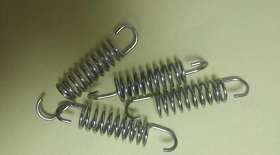Torsion bar spring and rubber spring
The torsion bar spring itself is a torsion bar made of spring steel. The end face of the torsion bar is usually round, and a few are rectangular and tubular. The shape of the two ends can be made into splines, squares, hexagons or cylindrical shapes with a plane, so that one end is fixed on the frame, the other end is fixed on the swing arm of the suspension, and the swing arm is connected with the wheel.
When the wheel bounces, the swing arm will swing around the axis of the torsion bar, causing the torsion bar to produce elastic deformation, so as to ensure the elastic connection between the wheel and the frame. Some torsion bars are made of thin strips (twisted pieces) with rectangular cross sections, so that the springs are more flexible. The torsion bar spring is made of chrome vanadium alloy spring steel and its surface is smooth after processing. The surface of the torsion bar must be well protected in use. Usually, the surface of the torsion bar spring is coated with epoxy resin, coated with glass fiber cloth, then coated with epoxy resin, finally coated with asphalt and rust-proof paint to prevent collision, scratch and corrosion, so as to improve the service life of the torsion bar spring.
Rubber spring is made up of elastic elements by the elasticity of rubber itself. It can withstand compressive loads and torsional loads. Its advantages are that it has more energy storage per unit mass than metal springs, good sound insulation performance, no noise and no need for lubrication. Because the internal friction of the rubber is large, the rubber spring has certain damping capacity. Rubber springs are mostly used as secondary springs and buffer blocks for suspension.
Welcome to the Mechanical parts Exhibition.



